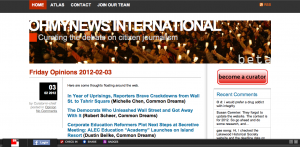The Internet has allowed the human civilization to break many barriers, whether that be language or geographical. Online forums and news sites have given us the privilege to connect and share information from community to community. With the ascension of the Internet, the invention of such sites skyrocketed.
An example of this “citizen journalism” is ohmynews.com. Ohmynews.com was founded in February 2000, by a South Korean journalist named Oh Yeon-ho, later to be known as a key player in the beginnings of citizen journalism.
If you want to learn more about Oh Yeon-ho, here is his biography.
Although ohmynews.com is well known for its back-and-forth journalism between users and reporters, it first started as a network similar to Yahoo! or CBC, strictly one direction in the way of news flow. However, the implementation of this “participatory journalism” really set it apart from larger networks due to its innovation and dependence on the users to share information. At first, ohmynews.com was exclusively focused in South Korea, but soon an English version of ohmynews.com was launched in 2004. Once rid of its language barrier, this allowed the platform to stretch globally on a much wider scale.
The main idea behind the site, that anyone and everyone could be a journalist, was what really drove ohmynews.com. Any person that had access to a computer could contribute to ohmynews.com, making it an innovative new tool to read up on news that was part of a much bigger picture, a global news community. Topics such as politics, society and culture, international affairs, education, the economy, technology, sports, and entertainment are all featured on ohmynews.com, providing to a broad range of interests.
Reddit is a similar and very popular platform in which users can post news and stories, which are moderated through other users and mediators, except in Reddit’s case, the site is more of a internet meme-factory.
Ohmynews.com allowed users to be more active when reading the news. Suddenly the user could be inclined to comment, post, and share, sometimes overwhelming the staff posts. The site has since been updated, and now features a recent comments bar where one can view the recent comments posted to different stories and follow and see what’s trending (like Twitter) and follow the most popular posts.
The new site also features a blog-like structure consistent with some of most popular sites today. The new blog layout is much more simple and easy to archive, considering how much content has built up over the last couple of years. This layout is much more efficient and less complicated than a forum-style site.
Nevertheless, ohmynews.com was the igniting spark that allowed citizen journalism to spread, in an easy and simple manner. It let regular people become journalists overnight and allowed the connection between reporter and reader to become dually significant, something that has shaped our society and our generation.
Sarah Kirkwood (31441116)


